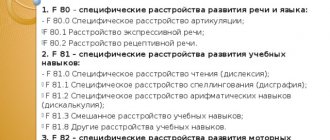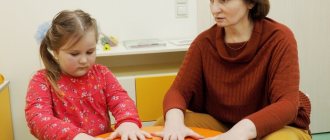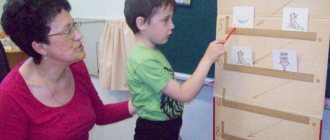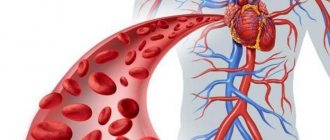Classification of dyslexia
Daria Novikova
Classification of dyslexia
Classification of dyslexia (Lalaeva Raisa Ivanovna)
:
Phonemic dyslexia occurs when phonemic perception is underdeveloped (difficulty in learning letters; replacement of letters that are acoustically and articulatory similar (B-P, D-T, S-Sh, Zh-Sh)
or underdevelopment of phonemic analysis functions (letter-by-letter reading, distortion of the sound-syllable structure of a word, omissions of consonants in clusters, insertions of vowels between consonants in clusters, permutations, omissions and rearrangements of syllables).
Semantic (mechanical reading)
impairment of reading comprehension
(words, sentences, text)
with technically correct reading (cannot correlate the word read and the object in the picture, cannot answer questions about the text) or unformed ideas about the syntactic connections of words in a sentence
(each word is perceived in isolation)
Agrammatically conditioned underdevelopment of the gram. structure of speech, morphological and syntactic generalizations (change in case endings of nouns, incorrect agreement in gender, number, case, change in the number of pronouns; incorrect use of gender endings of pronouns, change in the form of verbs.
Mnestic manifests itself in a violation of the assimilation of letters, in the difficulty of establishing connections between a word and a letter, undifferentiated substitutions of letters when reading, cannot reproduce a series of 3-5 letters or words, and violates the order of their occurrence
Optical is manifested by: replacement and confusion of graphically similar letters, undifferentiated visual representations, disturbances in optical-spatial perception; difficulties in perceiving letters written one below the other, not dividing the letters into their component elements, mirror reading.
Tactile is observed in blind children. The basis is the difficulty of tactilely differentiating the letters of the Braille alphabet.
Symptoms of dysgraphia manifest themselves in persistent and repeated errors in the writing process, which can be grouped as follows: distortions and substitutions of letters; distortion of the sound-syllable structure of a word; violations of the unity of spelling of individual words in a sentence; agrammatisms in writing.
Dysgraphia may also be accompanied by non-speech symptoms (neurological disorders, impairment of cognitive activity, perception, attentional memory, mental disorders). Dysgraphia (as well as dyslexia )
in children with normal intelligence it can cause various deviations in the formation of personality, certain mental layers.
Groups of dysgraphic errors:
1. errors at the letter and word level: omission of letters and syllables - does not highlight all its components in the word; letter substitutions – does not clearly correlate a phoneme with a grapheme; mixing letters - according to acoustic-articulatory similarity; permutations - it is difficult to analyze sounds in a word; insertions – observed at the confluence of acc. ; perseveration - due to the weakness of the differential. braking.
2.errors at the word level: separate spelling of parts of a word; combined writing of preposition and noun. ; contamination – start from one, end from another (beltok)
;
distortion of the structure of the sentence, when the boundaries of the sentence are not indicated, inconsistency of the members of the sentence (agrammatisms)
Classification of dysgraphia : The most reasonable is the classification of dysgraphia , which is based on the immaturity of certain operations of the writing process (developed by employees of the Department of Speech Therapy of Leningrad State Pedagogical Institute named after A. I. Herzen)
The following types of dysgraphia are distinguished: articulatory-acoustic, based on violations of phonemic recognition (differentiation of phonemes, based on violations of language analysis and synthesis, agrammatic and optical dysgraphia.
30. Methods of speech therapy work for dyslexia and dysgraphia . Main directions speech therapist work:
1. Development of phonemic awareness. (when eliminating phonemic dyslexia , articulatory-acoustic dysgraphia and dysgraphia based on violations of phonemic recognition). Differentiation of oppositional sounds and syllables is carried out based on various analyzers (speech-auditory, speech-motor, visual, etc.)
Improving auditory pronunciation.
differentiations carried out in close connection with the development of phonemic. analysis and synthesis (in the work of using assignments for the development of phonemic analysis and synthesis)
. Logowork on differentials. mixing sounds incl. 2 stages: Preliminary stage: the pronunciation and auditory image of each of the mixes is sequentially clarified. sounds. Work plan: clarifying the articulation and sound of sound with reference to visual, auditory, tactile. Perception, kinesthetic sensations; highlighting it against the background of the syllable; determining the presence and place in a word; determining the place of a sound in relation to other sounds; isolating it from a sentence or text. not only by ear, but also enshrined in letters. speech. Formation of phonemes. perception is carried out with the obligatory participation of the speech motor analyzer. Therefore, simultaneously with the development of phonemes. hearing and working on sound pronunciation. The stage of auditory and pronunciation differentiation of mixed sounds is wire. comparison of sounds in pronunciation and auditory terms. Differential sounds made in the same sequence (see above, but the main goal is to distinguish them, the following speech material, including words with mixed sounds. Each sound corresponds to a specific letter. Use of written exercise.
2. Work on sound pronunciation. First of all, it is necessary to eliminate shortcomings in the pronunciation of phonemes (distortion, replacement, lack of sound)
. In addition, it must be remembered that with impaired phonemic hearing, even intact sounds cannot be articulated absolutely clearly. At the initial stages of work, exclude pronunciation, i.e. because it can cause errors in writing.
3. Development of skills in language analysis and synthesis (with the elimination of phonemic dyslexia and dysgraphia due to violations of language development and synthea). Work on developing the skills of language analysis and synthesis is based on the development of the ability to determine the number, sequence and place of words in a sentence: come up with a sentence based on a plot picture and determine the number of words; I'll come up with an idea. offer with definition number of words; compound. proposed graphical diagram, etc.
4. Development of syllabic analysis and synthesis. Work begins. from use auxiliary techniques (clap, tap, name the number, then in terms of loud speech (the ability to isolate vowel sounds, preliminary work is carried out on differentiating vowels and consonants, isolating vowels from speech, an idea is given about G and S sounds, about the main features of their distinctions) and only then on the internal plane.
5. Development of phonemic analysis and synthesis. Considering sequence of forms. forms of sound analysis and synthesis in ontogenesis. Simple forms: highlighting the stressed G, row-syllable (um, na)
, on material of 2 or more syllables.
Complex forms of phoneme analysis go through stages: Stage 1 - forming. phonemes. analysis and synthesis with Oprah on auxiliary means (graphical diagram of words and chips)
and actions
(modeling of sequential sounds in a word)
. Stage 2 - formation. actions of sound analysis in the speech plane (except for reliance on the material from the actions, translated into the speech plane. Word, first, second, etc. sounds, their number). 3rd stage - forming. actions of phonemes. analysis and synthesis in mental terms, i.e. based on ideas.
6. Enrichment of vocabulary and development of practical ability to use it. This stage begins by teaching children different ways to create images. new words, eg. images words using different prefixes from one verb stem (u-went, came, came, went)
\ using one prefix from different chapters.
basics (came, brought)
. Another type of dictionary work is the selection of words with the same root, which improves spelling. For a long time In all classes, the vocabulary is expanded, clarified, and consolidated. stock of children. Ch. The task is to combine ex. by sound analysis of each word with clarification of its meaning and exercise. in a letter and th. Much work is being done to activate vocabulary.
5. Development of grammatical skills. The main tasks of this stage are working on understanding and using prepositions, composing sentences based on pictures, series of pictures, distributing and shortening sentences, etc.
6. Development of coherent speech, both oral and written.
Classes to eliminate deficiencies in writing and reading. are carried out for a long time. total academic of the year. A necessary condition for their effectiveness is the development of letters. and oral speech. Correcting deficiencies in writing and reading requires constant systematics. classes.
Elimination of agrammatic dyslexia and dysgraphia : the formation of morphological and syntactic generalizations, ideas about the morphological elements of words and sentence structure. Directions of work: clarification of sentence structure, development of the function of inflection and word formation, work on morphological analysis of the composition of words and with cognate words.
Elimination of optical dyslexia and dysgraphia : development of vision. perception (find from a number of others, crossed out, recognize colors, shapes, sizes (pick the same ones)
;
extended volume and clarification of vision. memory (which is gone)
;
formation of spatial representations (to the right, to the left of oneself/letters)
;
development of visual analysis and synthesis (construct a letter, put it together from sticks, find the given one)
.




